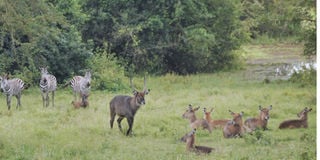Katonga reserve: A marvel in the wild

It will be hard for any tourist to miss out on the zebras and antelopes that are a popular sight at the Katonga Reserve. PHOTO BY ERONIE KAMUKAMA
Kampala-One hundred metres off Kyegegwa-Kazo road, the car engine starts to slow down before it completely collapses into silence.
It has been about four hours of driving from Kampala into southern Uganda.
Birds chirp through the bushes and treetops in pleasant choruses as if they are “welcoming me”.
As the chirps ripple into the afternoon, I rest to take in a fresh breath of fresh air to shake off the long drive.
This is Katonga Wildlife Reserve, a little-known protected area that was gazetted in 1964.
In a corner a distance away, three flags hang above Uganda Wildlife Authority (UWA) offices, the overseers of the reserve.
Samuel Amanya, the senior warden, is here to welcome me and in, he invites me into his office for procedural routines.
The reserve is a resort of its own located at the heart of River Katonga. It is closed off to the rest of world by a green lush that winds down in the bushes and thickets.
“It [reserve] is named after Katonga River or Katonga River is named after it. It is difficult to know which one came first,” Amanya breaks the awkward silence.
The 210 square kilometer stretch on which Katonga sits, defines the wilderness that UWA has slowly been transforming into a tourist destination.
The reserve is a marvel with a fine campsite, a dining area sheltered in a gazebo and fine tents, some definitely great for a honeymoon.
For a bird’s view, Amanya leads me to Izina Hill, where I get the real picture of the reserve.
Here, I encounter bushbucks, warthogs, zebras, waterbucks and herds of impalas.
The reserve sits within the south-western districts of Kyegegwa and Kamwenge, before hugging the boundary of Kiruhura District.
On the outskirts are several UWA outposts to ensure no one illegally accesses the reserve.
With an inquisitive thoughts, I slip deep into the reserve to explore.
I have been told the Sitatunga, an animal from the antelope family, resides here. This is among the very few places where it if found.
It is a rough experience as I have to break through the bushy and somehow muddy track.
“The Sitatunga is only found in central and east Africa. The marshy swamps of the Katonga are its cradle,” Amanya tells me.
On the track, my muddy shoes can barely carry my now heavy foot that continue to dig in deep as I approach the end of the swampy stretch covered with papyrus.
“Tracking Sitatungas is the most difficult but pleasant activity in the wilderness,” Amanya says, introducing me to the adventurous side of the Katonga Reserve.
“It [track] is a 35-kilometre trail, going along the swamp up to Katonga River. There are also many places where you can hike,” he says.
Between our tracking, Amanya introduces me to an improvised ladder-like structure, which he tells me provides the best view of Katonga.
“With some level of investment, this ladder and the platform can be professionally done and the tree can only work as a cover,” he says.
Here, frogs croak in unison joined by hippos that grunt into the approaching dark. Darkness is first approaching and from the look of things, I will not see the Sitatunga today.
Slowly, we head back to the campsite, before moving into a nearby trading centre to catch dinner.
Kabagore, the nearby trade centre, has a seemingly quite life as much of it is covered in darkness without electricity.
The bad side
The centre has no restaurant or accommodation venues to talk of with the best option being a night in a tent or the reserve’s education centre.
After a night of some heavy sleep, the next day comes with a little freshness and energy to explore some more.
From the day’s list, Dozen Hills, unique to Katonga, sounds exciting and on, we drive through the dusty roads stretching through scanty trees, thick papyrus and forestland.
Slowly, we thread our way into the hills catching a sight or two at the now dilapidated Uganda Railways offices and Kataraza where Kiruhura, Kyegegwa and Kamwenge meet.
“These are twelve hills within the middle of Katonga Wildlife Reserve and to reach them, you have to cross two rivers,” Amanya says, signaling me to a boat that has to sail us to the other end of the river.
The hills provide a perfect marvel that tells the beauty of the Katonga stretch.
“You can choose to have breakfast on one and lunch on another hill and camp on the third. It is so unique that you will not find this kind of challenge anywhere,” Amanya says.
The challenge
The mervel that is Katonga Reserve has not been without challenges. The reserve has insufficient investments to give tourists a worthy experience.
Access roads are still non-existent and accommodation continues to be a problem within and around.
“A sharp investor would establish lodges on the dozen hills [pictured],” Amanya says, however, he is oblivious of the fact that tourist numbers are still low.
On average, about 15 tourists visit the reserve per month. A number of animals including 46 zebras and 31 topis have been translocated into the reserve and plans are underway to transfer some buffaloes and elands.
But hope, as Amanya says, is built on the proposed railway line from Malaba passing through Katonga
“People will travel in one hour, do game drives and travel back,” he says.




